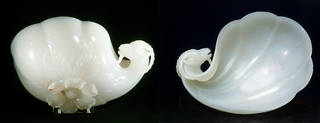The cup was made in 1657 for Shah Jahan who ruled the Mughal Empire from 1628 to 1658. Shah Jahan was descended from Amir Timur, a ruthless Central Asian conqueror, who swept across the Middle East and India during the 14th century. Timur's fame was such that far away in England he was celebrated in Christopher Marlowe's play Tamburlaine two centuries after his lifetime.

The cup is shaped like a gourd with the handle carved into the head of a ram. The base features acanthus leaves radiating out from a lotus flower which is raised to form a pedestal for the cup. The different features of the cup reflect the variety of cultural and artistic influences that were welcomed at the Mughal court. Persian in their cultural background and Indian by adoption, the Mughals were also open to new ideas from the West. Jesuits at the Mughal court, entertaining futile ideas of converting an Empire, were welcomed for their learning; ambassadors and merchants for their exotic gifts and promises of trade. Craftsmen-adventurers were especially welcomed for their skills and knowledge of unfamiliar technologies.
The use of a gourd form for the body of the cup is Chinese in inspiration, while the lotus petals and sensitivity of animal portraiture are characteristic features of Hindu art. The ideas of the pedestal support and the use of acanthus leaves are also European in origin and parallel similar elements in the decoration of Mughal architecture during Shah Jahan's reign.
Yet for all its eclecticism, with features from China, Iran, Europe and India, the art of the Mughals achieved a brilliant unity. This unity is perfectly exemplified in the jade cup which entered Shah Jahan's treasury in the last year of his reign and now provides such strong visual support to the legend of the dynasty's splendour.

